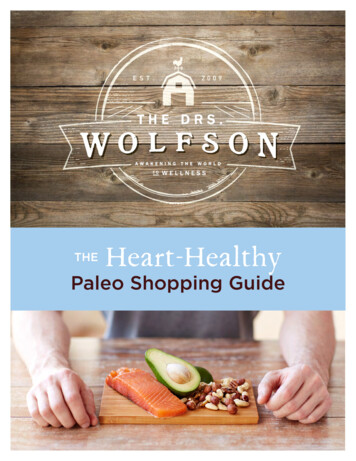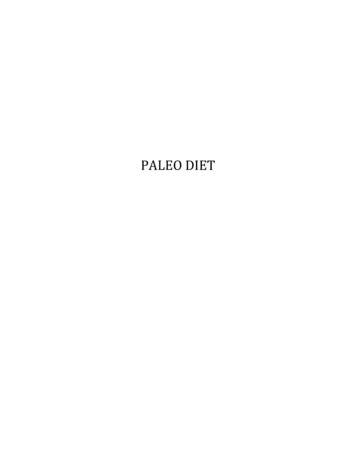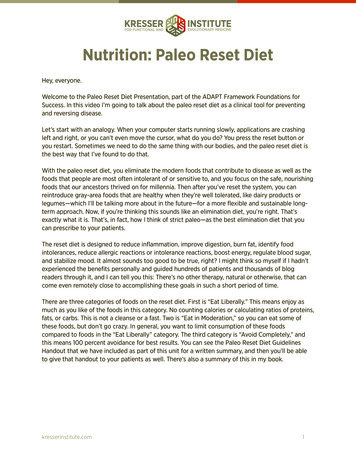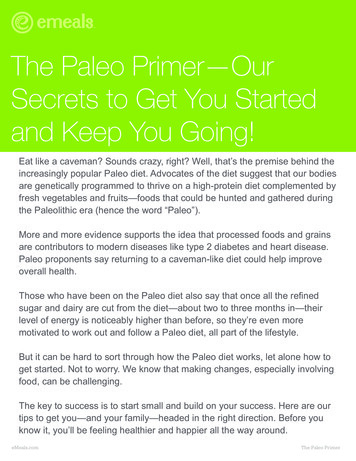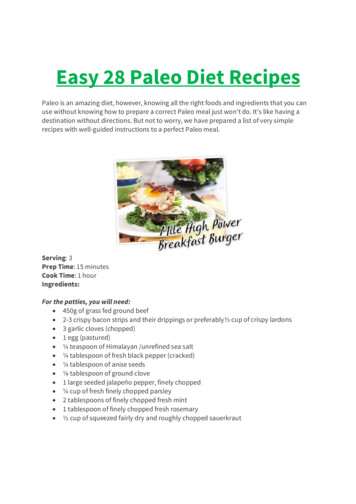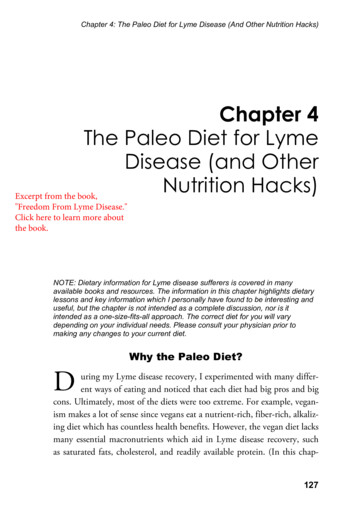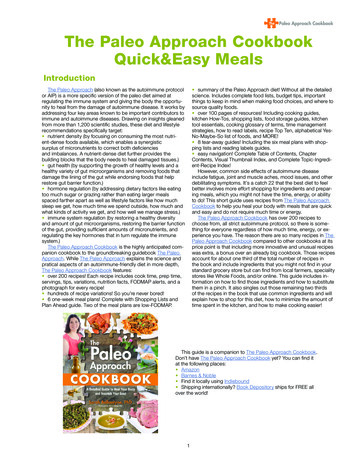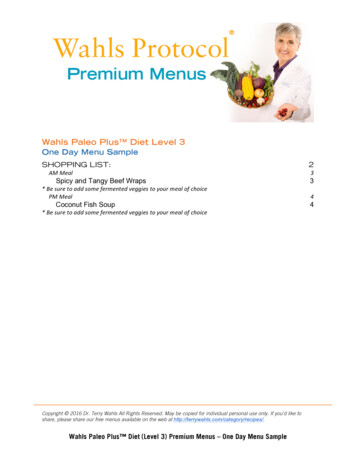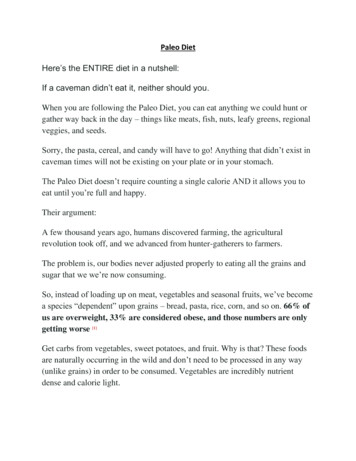
Transcription
What is the Paleo Diet?The concept of the Paleolithic Diet is to get back to ancient times. When adopting this dietary approach, you are going to forego all theprocessed foods you find at the supermarket and instead focus on foods that either occur in the wild or come straight from the ground.Essentially, if it was available thousands of years ago, it is going to have a place in your meal plan. This means that your daily diet willprimarily consist of meat (grass feed beef is preferred) and fish, plenty of fresh fruits and vegetables, as well as nuts and seeds. Oils aretypically allowed in moderation. Foods to be avoided included dairy products, cereal grains, legume's, starchy vegetables, fatty meats, andfoods that are very high in salt content (such as processed meat products and salted nuts).Paleo Recipe of theMonth:Pros vs. Cons : Paleo DietPros:Cons:Nutritious: Since it lacks today's processed foodswhich are relatively "nutritionally empty", there is nodoubt that this diet has a high nutrient density. Inmost cases it will far exceed the minimum requirements for vitamins and minerals, although individualchoices could influence this.Requires Huge Adjustment: Even more than mostlow carb diets, eating this way would almost certainlyrequire an enormous change in eating. We are told to"shop the perimeter of the grocery store" (which iswhere the foods for this diet primarily are found),however few of us actually stay there. This diet canalso make it more difficult for an athlete to consumethe number of calories that are needed.Stable Energy Levels (eat throughout the day): ThePaleo diet relies heavily on whole meats, vegetablesand fruits. These foods digest slowly, keeping bloodsugar levels stable throughout the day. Stable bloodsugar eliminates the energy and mood swings thatcan result from a diet high in processed carbs andrefined sugar.Simple: No counting or measuring. You eat from thefood lists, and that is that.Emphasis on Physical Activity: Increasing activitylevels is seen to be an integral part of the PaleolithicPlan.Inconvenient: Processed grains and dairy are widelyused in prepared foods. They are also not allowed onthe Paleo diet. Consequently, Paleo dieters often findit difficult to dine out or grab meals on the go. Fastfood is often out of the question, as are most nonperishable options, excluding nuts.There is still quite a debate about what constitutes a"proper" Paleo diet, and practitioners get quitetouchy about it. Still, there is more overlap than notamong the various authors. One point that has beenbrought up is that clearly there are groups of peoplewho have made a genetic adaptation to eating milkand other dairy products those people should goahead and eat them.Can be expensive: Grass fed beef, for example, canbe hard to find in some places, and almost alwayscosts quite a bit more.A Note on Calcium: A frequently asked questionabout this diet is how a person gets enough calciumwithout dairy. Greens are rich in calcium.Muffin OmeletIngredients: coconut oil or paper muffinliners6 eggs1/2 red bell pepper1/4 dry sage5 oz spinach3/4 lb chicken, ham, or sausage, cooked and cut orcrumbled into small pieces 1/4 tsp salt1.Preheat oven to 350 degrees.2.Heat the skillet and add chicken sausage.3.Add bell peppers and green onions to the cookedchicken. Cook until tender.4.Drain any excessive oils or liquids.5.Stir in the chopped spinach to the chicken andvegetables.6.Let chicken and vegetables cool after being cooked.7.Grease 8 muffin cups with coconut oil or line withpaper baking cups. Fill any remaining muffin cups with1" of water, so they do not scorch while baking.8.Beat the eggs in a medium bowl and add meat, vegetables, salt, ground pepper, and any other ingredientsyou wish to add.9.Pour mixture into the muffin cups.10.Bake for 18-20 minutes.Directions:
BEHIND THE LINEIn this month’s interview we sit down Nina Secerbegovic. This senior comes to us from Tulza,Bosnia. Through this senior’s determination and grit, she has found a great deal of successwhile at Baylor. This past month, Nina was awarded her fifth Big 12 Player of the Week of hercareer. As a leader of the 2012 Baylor Women’s Tennis team and seasoned veteran, Nina hastaken the time to share some of her lessons and aspirations for the future with us in Behindthe Line.First off, congrats on receiving Big 12 player of the week. What’s What is your most memorable moment while at Baylor?receiving this award mean to you?“Definitely Semis in the NCAA tournament. It’s always a wonderful“It’s a great honor, especially when you win so many of them, soexperience.”often”.What is an interesting fact about you?So I see you’re from Bosnia, why did you choose Baylor University?“I have had previous teammates who have played here and forTennis. They have a top 10 team and I wanted to be a part ofsomething big.”“I speak four languages: English, German, Spanish and Japanese. Ialso have a pretty good singing voice”.Have you ever participated in any other sports?“No I have only played tennis”Do or did any of your family play tennis? How is it that you cameabout playing tennis?“My mom played tennis as a kid and my dad played professionalsoccer and even competed in the Olympics. I have always had amental edge from my dad, he has coached me since I was young.”How has your experience been at Baylor thus far?“Baylor has prepared me for life. It has been great, bad andtough kind of like a rollercoaster. I have no regrets and this experience of being at Baylor will be in my memory forever.”I see you have won many awards and titles ranging from NCAASingles All-American to Big 12 Singles and Doubles Champion.What is your goal for your senior year?“I hope to win the championship this year with my team! I wouldlove to become a double all-American as well as make the Dean’sList.”How do you think strength and conditioning has affected yourperformance in tennis?“I would say that strength and conditioning has strengthened meas well as prevented injuries”After graduation in May, do you plan to return home or stay inthe states? Do you plan on making tennis your career?“I plan on attending grad school in Japan. As much as I love tennis,I would like to take a bit of a break to allow my body to recover.”What is one thing after leaving Baylor that you will take withyou?“Something I will take with me is that, although life is hard, it canbe very enjoyable.”Do you have anything else you would like to say?You’ve gained a reputation for being passionate and competitive, “Believe and always try your best!”who has been the biggest influence in your daily approach tocompeting?“My dad has definitely been a big influence on me. It has beengood and bad, because he really does not like to lose, so I thinkemotionally I can be pretty hard on myself.”
This month we will begin discussing how the body utilizes and creates energy. The end goal of mostmetabolic processes is to create adenosine tri-phosphate (ATP) which is the body’s energy source foractivity. In part one of this series we will discuss the aerobic system.What is the Aerobic System ?WORD BANKDuring rest, light or prolonged moderate exercise the body primarily utilizes aerobic pathways forATP production. The aerobic system also facilitates ATP regeneration during rest periods in manyteam sports (football, soccer, volleyball). Aerobic respiration takes place in the mitochondria and requires oxygen in combination with glucose to drive a series of chemical events where the end productis carbon dioxide, water, and ATP. The carbon dioxide is released into the blood and removed from the body throughthe lungs. Fuel for this oxidative process may come from muscle glycogen, blood glucose or pyruvic acid (primarily early on in activity) and move to free fatty acids later on in exercise. The body may even use some amino acids for fuelduring aerobic activity. This process yields a high level of ATP (36 per molecule of glucose) but it is a relatively slow process because of the number of chemical steps it takes to turn the fuel to energy, it also requires a steady flow of oxygen to continue the process.Mitochondria: provide energy to the cell that is needed to move, divide,produce products and contract. This are the power centers for the cell.Muscle Glycogen: is an important fuel for contracting skeletal muscle during prolonged strenuous exercise. Glycogen depletion has been implicatedin muscle fatigue.Glucose: is a simple sugar (monosaccharide) and an important carbohydratein biology.Blood Glucose: the concentration of glucose in the blood, represented inmilligrams of glucose per deciliter of blood.Oxidative Process: a process where oxygen combines with other molecules.Pyruvic Acid: is an organic acid, a ketone, as well as the simplest of the alpha-keto acids.
elf-ControlIndustriousnessFriendshipTeam SpiritInitiativeAlertnessLoyaltyBuildingBlocks ofsuccessIntentnessCooperationEnthusiasmAt the pinnacle of Coach John Wooden Pyramid of success stands “Competitive Greatness”. The legendary Coach defined Competitive Greatnessas “A real love for the hard battle, knowing it offers the opportunity to be at your very best when your best is required”. All great competitorsdesire to be at their very best during the times of team or individual competition. They embrace the struggle and hard battles of preparation withthe ultimate goal in mind. It is with these goals in mind the great competitors sacrifice time, energy and health for team and individual achievement. They prepare with a big picture mindset instead of focusing on their current state of being. These great competitors truly live by the oldadage “When the going gets tough, the tough gets going.”
Paleo diet relies heavily on whole meats, vegetables and fruits. These foods digest slowly, keeping blood sugar levels stable throughout the day. Stable blood sugar eliminates the energy and mood swings that can result from a diet high in processed carbs and refined sugar. Simple: No countin
